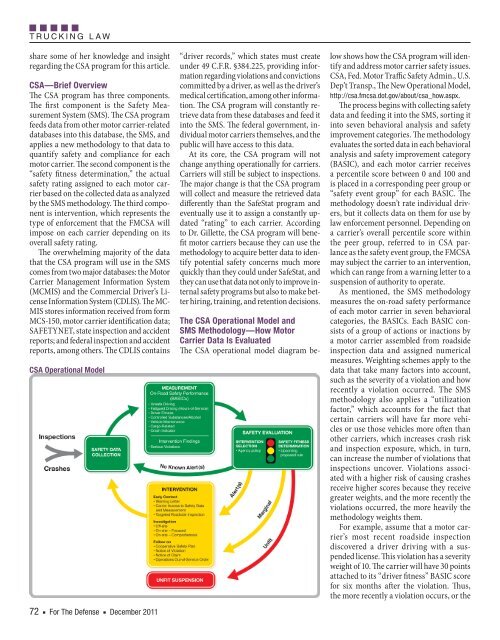For The Defense, December 2011 - DRI Today
For The Defense, December 2011 - DRI Today
For The Defense, December 2011 - DRI Today
You also want an ePaper? Increase the reach of your titles
YUMPU automatically turns print PDFs into web optimized ePapers that Google loves.
Trucking Law<br />
share some of her knowledge and insight<br />
regarding the CSA program for this article.<br />
CSA—Brief Overview<br />
<strong>The</strong> CSA program has three components.<br />
<strong>The</strong> first component is the Safety Measurement<br />
System (SMS). <strong>The</strong> CSA program<br />
feeds data from other motor carrier- related<br />
databases into this database, the SMS, and<br />
applies a new methodology to that data to<br />
quantify safety and compliance for each<br />
motor carrier. <strong>The</strong> second component is the<br />
“safety fitness determination,” the actual<br />
safety rating assigned to each motor carrier<br />
based on the collected data as analyzed<br />
by the SMS methodology. <strong>The</strong> third component<br />
is intervention, which represents the<br />
type of enforcement that the FMCSA will<br />
impose on each carrier depending on its<br />
overall safety rating.<br />
<strong>The</strong> overwhelming majority of the data<br />
that the CSA program will use in the SMS<br />
comes from two major databases: the Motor<br />
Carrier Management Information System<br />
(MCMIS) and the Commercial Driver’s License<br />
Information System (CDLIS). <strong>The</strong> MC-<br />
MIS stores information received from form<br />
MCS-150, motor carrier identification data;<br />
SAFETYNET, state inspection and accident<br />
reports; and federal inspection and accident<br />
reports, among others. <strong>The</strong> CDLIS contains<br />
CSA Operational Model<br />
72 ■ <strong>For</strong> <strong>The</strong> <strong>Defense</strong> ■ <strong>December</strong> <strong>2011</strong><br />
“driver records,” which states must create<br />
under 49 C.F.R. §384.225, providing information<br />
regarding violations and convictions<br />
committed by a driver, as well as the driver’s<br />
medical certification, among other information.<br />
<strong>The</strong> CSA program will constantly retrieve<br />
data from these databases and feed it<br />
into the SMS. <strong>The</strong> federal government, individual<br />
motor carriers themselves, and the<br />
public will have access to this data.<br />
At its core, the CSA program will not<br />
change anything operationally for carriers.<br />
Carriers will still be subject to inspections.<br />
<strong>The</strong> major change is that the CSA program<br />
will collect and measure the retrieved data<br />
differently than the SafeStat program and<br />
eventually use it to assign a constantly updated<br />
“rating” to each carrier. According<br />
to Dr. Gillette, the CSA program will benefit<br />
motor carriers because they can use the<br />
methodology to acquire better data to identify<br />
potential safety concerns much more<br />
quickly than they could under SafeStat, and<br />
they can use that data not only to improve internal<br />
safety programs but also to make better<br />
hiring, training, and retention decisions.<br />
<strong>The</strong> CSA Operational Model and<br />
SMS Methodology—How Motor<br />
Carrier Data Is Evaluated<br />
<strong>The</strong> CSA operational model diagram be-<br />
low shows how the CSA program will identify<br />
and address motor carrier safety issues.<br />
CSA, Fed. Motor Traffic Safety Admin., U.S.<br />
Dep’t Transp., <strong>The</strong> New Operational Model,<br />
http://csa.fmcsa.dot.gov/about/csa_how.aspx.<br />
<strong>The</strong> process begins with collecting safety<br />
data and feeding it into the SMS, sorting it<br />
into seven behavioral analysis and safety<br />
improvement categories. <strong>The</strong> methodology<br />
evaluates the sorted data in each behavioral<br />
analysis and safety improvement category<br />
(BASIC), and each motor carrier receives<br />
a percentile score between 0 and 100 and<br />
is placed in a corresponding peer group or<br />
“safety event group” for each BASIC. <strong>The</strong><br />
methodology doesn’t rate individual drivers,<br />
but it collects data on them for use by<br />
law enforcement personnel. Depending on<br />
a carrier’s overall percentile score within<br />
the peer group, referred to in CSA parlance<br />
as the safety event group, the FMCSA<br />
may subject the carrier to an intervention,<br />
which can range from a warning letter to a<br />
suspension of authority to operate.<br />
As mentioned, the SMS methodology<br />
measures the on-road safety performance<br />
of each motor carrier in seven behavioral<br />
categories, the BASICs. Each BASIC consists<br />
of a group of actions or inactions by<br />
a motor carrier assembled from roadside<br />
inspection data and assigned numerical<br />
measures. Weighting schemes apply to the<br />
data that take many factors into account,<br />
such as the severity of a violation and how<br />
recently a violation occurred. <strong>The</strong> SMS<br />
methodology also applies a “utilization<br />
factor,” which accounts for the fact that<br />
certain carriers will have far more vehicles<br />
or use those vehicles more often than<br />
other carriers, which increases crash risk<br />
and inspection exposure, which, in turn,<br />
can increase the number of violations that<br />
inspections uncover. Violations associated<br />
with a higher risk of causing crashes<br />
receive higher scores because they receive<br />
greater weights, and the more recently the<br />
violations occurred, the more heavily the<br />
methodology weights them.<br />
<strong>For</strong> example, assume that a motor carrier’s<br />
most recent roadside inspection<br />
discovered a driver driving with a suspended<br />
license. This violation has a severity<br />
weight of 10. <strong>The</strong> carrier will have 30 points<br />
attached to its “driver fitness” BASIC score<br />
for six months after the violation. Thus,<br />
the more recently a violation occurs, or the

















